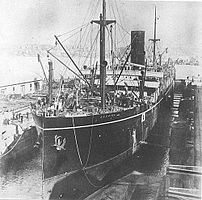Berrima (ship, 1913)
|
The Berrima, still under construction (1913)
|
||||||||||||||||||||
|
||||||||||||||||||||
|
||||||||||||||||||||
|
||||||||||||||||||||
|
||||||||||||||||||||
|
||||||||||||||||||||
The Berrima was a passenger ship of the British shipping company Peninsular and Oriental Steam Navigation Company (P&O), which was put into service in 1913 and was used in emigrant traffic from Great Britain to Australia . During the First World War , the ship survived a submarine attack in service as a troop transport and was back in regular passenger traffic after the war. In 1930 the Berrima was sold to Japan for demolition.
The ship
In 1910 P&O bought the shares in the British shipping company Blue Anchor Line (London), which had not recovered from the loss of its passenger ship Waratah the year before. P&O took over the Blue Anchor Line's Australian service and renamed it the P&O Branch Line. The Caird & Company shipyard in Greenock , Scotland , immediately placed orders for five new sister ships for the new emigrant traffic to Australia. The 11,120 GRT Ballarat was the first of these five ships to be completed in 1911 . It was followed by the Beltana (11,120 GRT) in 1912 , the Benalla (11,118 GRT) and the Berrima (11,137 GRT) in 1913 and the Borda (11,136 GRT) in 1914 . The cost of building the Berrima alone was £ 209,456 (in monetary terms at the time ).
The 152.43 meter long steamship Berrima had a chimney, two masts and two propellers and was powered by two four-cylinder quadruple expansion steam engines from the shipyard, which developed 9,000 PSi and enabled a speed of 14 knots . The ship had space for 600 third class passengers. Since the Berrima was intended for pure emigration traffic, there was no first or second class. On September 20, 1913, the ship was launched at Caird & Company and on December 5, 1913, it was handed over to P&O. The maiden voyage took place in the same month. The usual route ran from London via Cape Town to Melbourne and Sydney .
First World War
After the outbreak of World War I in 1914, the Berrima was converted into an auxiliary cruiser for the Royal Australian Navy (RAN) in the docks of Cockatoo Island . On August 19, 1914, she left Sydney on her first war voyage as HMAS Berrima , transporting men from the Australian Naval and Military Expeditionary Force (AN & MEF) for missions against German New Guinea . Troops were landed on September 11th in Herbertshöhe (today Kokopo), on September 12th in Simsponhafen (today Rabaul) and on September 24th on the main island of New Guinea . In March 2010, the ship was awarded the Battle Honor "Rabaul 1914" to commemorate this event.
After returning to Sydney, the ship was converted again and put into service as a troop transport under the name HMATT (His Majesty's Australian Troop Transport) Berrima . In December 1917 she ran out with Australian and New Zealand soldiers as part of the second convoy to the Middle East . On December 31, 1914, she towed the Australian submarine AE2 as part of the second convoy of the Australian Imperial Force from the port of Albany (the submarine was to be escorted to Europe at the behest of the RAN and the British Admiralty ).
In 1917 the ship fell under the Liner Requisition Scheme and was used for patrol trips on the North Atlantic . On February 18, 1917, the Berrima was 50 nautical miles west of Portland Bill, the southern tip of the Isle of Portland on the English south coast, when she was torpedoed by the German submarine U 84 under the command of Lieutenant Walter Roehr (position 50.22N , 02.44W). The ship was with Australian goods on a crossing from Fremantle to London .
Four people were killed by the torpedo impact (according to other sources it was a sea mine ), but the Berrima did not sink . The crew left the ship in the lifeboats and were picked up by the destroyer Forester . The Berrima was taken in tow by the tug pilot and towed into the port of Portland the next day . In the absence of a dry dock , the ship was repaired while floating.
Post-war years
After the end of the war, the Berrima was returned to her owners and put into Australian passenger service. On February 1, 1920, she was on her way back to England with 275 passengers on board when she ran aground near Margate on the Kent coast due to a piloting error corrected too late by the master. The following day she was brought afloat again by the tugs Firm , Lady Brassey , Lady Duncan , Scotia and Java .
On March 24, 1920, the Berrima made a one-off trip for the British India Steam Navigation Company from London via Suez and Colombo to Brisbane . In 1927, 27 stokers on the ship were arrested for theft. On April 26, 1929, the Berrima left for her last voyage to Australia. On July 16, 1930, it was sold to Asakichi Kitagawa in Japan for £ 29,000 and scrapped in Osaka .

